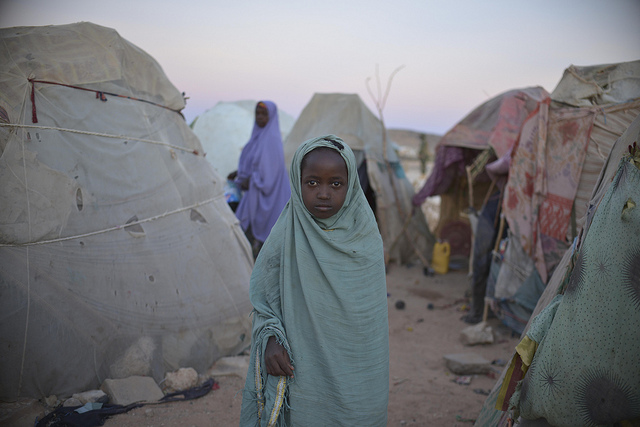Term: Displaced Person
Definition and Background
A displaced person is “a person who is forced to leave their home country because of war or persecution” (Stevenson, Oxford Dictionary of English, 2015). Other synonyms for a displaced person include a refugee or internally displaced person. While social causes are the most common reason for relocation, environmental factors or economic changes may also cause people to leave their home country in search of better living conditions. The handling of displaced persons differs by country as each government has different policies, but it often falls to the humanitarianism efforts of international agencies. International agencies play a growing role as the number of displaced persons grows and conflicts erupt worldwide.
Topical Context
According to Britannica Academic, the first form of international refugee assistance was provided to displaced persons after World War I in 1921 from the League of Nation. Additionally, the American Relief Administration (ACA) provided food and clothes and worked to repatriate the displaced persons (Cohen 2008, 437). When World War II ended, the United Nations Relief and Rehabilitation Administration (UNRAA) was created in 1943 to handle the large number of people displaced from the war. In 1946, the International Refugee Organization (IRO) took over for the UNRAA (Britannica Academic, 2017). Cohen argues that the UNRAA created a new alternative welfare state that played a key political role in shaping the postwar climate through its organization of refugee camps (Cohen 2008, 439). The organizations that provided post conflict humanitarianism efforts after World War I were described as “independent courses” in a “charitable phase,” while post conflict humanitarianism following World War II, coined “modern humanitarianism,” shifted to the public realm in the rise of “a Super-state body in charge of relief” (Cohen 2008, 437-438). Therefore, the handling of displaced persons throughout history, especially after World War II, has become increasingly politicized as the Red cross and other philanthropies were overshadowed by emerging international organizations.

Fig. 1. Tobin Jones, A girl stands in an IDP camp on the outskirts of Belet Weyne
Controversy
Debate surrounds the availability of health care, specifically reproductive health care, to internationally displaced persons. Currently, there is no legal recognition for displaced persons and they aren’t included in any mandates from the UNHCR (Hakamies, Geissler, and Borchert 2008, 34). Therefore, displaced persons are excluded from health care services provided by humanitarian agencies and so there is no comprehensive reproductive health care provided. National authorities are generally neglectful surrounding access to reproductive health care because reproductive health care is politically sensitive and seen as less important than other health needs. Therefore, donors have been reluctant to intervene and so donor funding has decreased (Hakamies, Geissler, and Borchert 2008, 34). A study done by Nina Hakamies, Paul Geissler, and Matthias Borchert examined the barriers to providing reproductive health to displaced persons and found that “financial constraints make agencies fight for the same funds” (2008, 40). Because reproductive health care is not seen to be as important as other health needs, it is often not included when funds are limited. They argued that agencies should be working together instead of fighting for limited funds, but the decreasing donations and financial constraints prevents this from happening (Hakamies, Geissler, and Borchert 2008, 43). Therefore, monetary restrictions limit the ability of humanitarian agencies to provide reproductive health care to displaced persons.
However, looking forward, Hakamies, Geissler, and Matthias state that reproductive health care is becoming increasingly recognized as a basic human need by humanitarian agencies and the international community (2008, 34). Guidelines, like the UNOCHA’s Guiding Principles on Internal Displacement, are starting to include plans for providing reproductive health care to conflict-affected populations. (2008, 34). Therefore, future advocacy for internationally displaced persons will try to break down barriers that prevent displaced persons from receiving reproductive health care, a population that could be argued to need it the most.
Relation to Politics of Health
As discussed earlier, modern humanitarianism for displaced persons that emerged after World War II is becoming increasingly politicized (Cohen 2008, 439). Cohen argues that the modern humanitarianism displayed post World War Ii echoed the main political blueprints of the war, a climate defined by religious and ethnic divisions, and therefore influenced the shaping of the postwar world (Cohen 2008, 449). Refugee camps were organized by ethnicity, nationality and religion (Cohen 2008, 448). As modern humanitarianism plays a larger role in the political sphere, the treatment of displaced persons becomes increasingly important. As shown by Cohen through the example of World War II, the management of displaced persons can be demographically based, therefore creating unequal power structures and disparity in society. With regards to health, this inequality can limit access to health care and result in poor health status for displaced persons. As humanitarianism increasingly becomes based on the political climate, the treatment of displaced persons could suffer.
Works Cited
Britannica Academic, s.v. “Office of the United Nations High Commissioner for Refugees,” by
Karen Mingst, accessed April 12, 2017, http://academic.eb.com.proxy.library.vanderbilt.edu/levels/collegiate/article/Office-of-the-United-Nations-High-Commissioner-for-Refugees/74311#
Cohen, G. Daniel. 2008. “Between Relief and Politics: Refugee Humanitarianism in Occupied
Germany 1945-1946.” Journal of Contemporary History 43: 437-49. doi: 10.1177/0022009408091834
Hakamies, Nina, Paul Wenzel Geissler, and Matthias Borchert. 2008. “Providing Reproductive
Health Care to Internally Displaced Persons: Barriers Experienced by Humanitarian Agencies.” Reproductive Health Matters 16, no. 31: 33-43. http://www.jstor.org.proxy.library.vanderbilt.edu/stable/25475363.
Oxford Dictionary of English, 3rd ed., s.v. “displaced person,” edited by Angus Stevenson,
accessed April 12, 2017, http://www.oxfordreference.com.proxy.library.vanderbilt.edu/view/10.1093/acref/9780199571123.001.0001/m_en_gb0231900
Tobin Jones, A girl stands in an IDP camp on the outskirts of Belet Weyne on February 20.
- AU UN IST Photo, Belet Weyne. Available from Flickr Commons, https://flic.kr/p/e1Zqwv (accessed April 12, 2017).
« Back to Glossary Index
